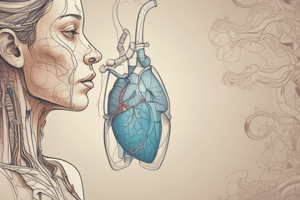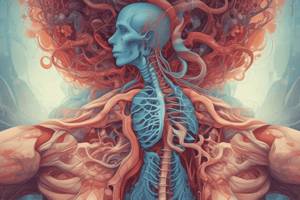Podcast
Questions and Answers
What primarily regulates the amount of carbon dioxide exhaled?
What primarily regulates the amount of carbon dioxide exhaled?
- The lungs alone
- The heart function
- The kidneys
- The brain (correct)
How does increased ventilation affect blood acidity?
How does increased ventilation affect blood acidity?
- It has no effect on acidity
- It lowers acidity by reducing CO2 (correct)
- It raises acidity by increasing CO2
- It raises acidity by reducing O2
Where are central chemoreceptors located?
Where are central chemoreceptors located?
- In the carotid bodies
- In the heart
- In the lungs
- On the surface of the medulla oblongata (correct)
What happens when blood CO2 levels rise?
What happens when blood CO2 levels rise?
Which process is used by tissue macrophages in the alveolar wall?
Which process is used by tissue macrophages in the alveolar wall?
What effect does decreased ventilation have on CO2 and blood pH?
What effect does decreased ventilation have on CO2 and blood pH?
What forms the primary defense against foreign particles in the respiratory system?
What forms the primary defense against foreign particles in the respiratory system?
What is the main outcome of increased depth and rate of respiration?
What is the main outcome of increased depth and rate of respiration?
Which process involves the movement of air between the lungs and the atmosphere?
Which process involves the movement of air between the lungs and the atmosphere?
What is the primary mechanism the body uses to regulate blood pH?
What is the primary mechanism the body uses to regulate blood pH?
What role do pulmonary macrophages play in the respiratory system?
What role do pulmonary macrophages play in the respiratory system?
How does the body maintain acid-base balance in the blood?
How does the body maintain acid-base balance in the blood?
Which of these is NOT considered a non-respiratory function of the respiratory system?
Which of these is NOT considered a non-respiratory function of the respiratory system?
What is the significance of chemoreceptors in the respiratory system?
What is the significance of chemoreceptors in the respiratory system?
Which substance is secreted by the respiratory mucus membrane to aid in immune defense?
Which substance is secreted by the respiratory mucus membrane to aid in immune defense?
How does increased ventilation affect blood pH?
How does increased ventilation affect blood pH?
What is the primary function of the respiratory membrane?
What is the primary function of the respiratory membrane?
Which of the following accurately describes the conditions within the pleural cavity?
Which of the following accurately describes the conditions within the pleural cavity?
What role do chemoreceptors play in the respiratory system?
What role do chemoreceptors play in the respiratory system?
What effect does sympathetic stimulation have on the bronchi?
What effect does sympathetic stimulation have on the bronchi?
How does ventilation influence acid-base balance in the body?
How does ventilation influence acid-base balance in the body?
What type of blood does the pulmonary arteries carry?
What type of blood does the pulmonary arteries carry?
What separates the visceral and parietal layers of the pleura?
What separates the visceral and parietal layers of the pleura?
Which structure facilitates the exchange of gases in the lungs?
Which structure facilitates the exchange of gases in the lungs?
Flashcards are hidden until you start studying
Study Notes
Respiratory System Overview
- Respiration involves the exchange of oxygen (O2) and carbon dioxide (CO2) between the body and the environment.
- Composed of two parts: External respiration (gas exchange with the atmosphere) and internal respiration (cellular use of O2 and production of CO2).
External Respiration Processes
- Pulmonary Ventilation: Movement of air in and out of the lungs.
- Gas Exchange: Occurs between alveoli and surrounding capillaries via simple diffusion.
- Transport of Gases: O2 and CO2 are carried by the blood between lungs and tissues.
- Gas Exchange in Tissues: O2 delivery and CO2 uptake at body tissues.
Internal Respiration
- Utilizes O2 for energy production in cells, resulting in CO2 as a byproduct.
Functions of the Respiratory System
- Respiratory Function: Primary function is to supply O2 and eliminate CO2.
- Acid-Base Balance: Regulates blood pH by managing CO2 levels; excess CO2 decreases pH (increases acidity).
- Phonation: Production of sound through air vibrations in the vocal cords.
- Olfactory Sensation: Sense of smell through receptors located in the nasal cavity.
- Immune Function: Airway defense against pathogens via tissue macrophages in alveoli.
- Filtration Function: Respiratory mucosa traps particles and pathogens, filtering the incoming air.
- Temperature and Water Regulation: Maintains body temperature and moisture levels.
- Metabolic Functions: Activation of angiotensin I to angiotensin II by angiotensin-converting enzyme (ACE).
Regulation of Ventilation
- The brain adjusts the speed and depth of breathing based on CO2 accumulation and blood pH.
- Chemoreceptors: Detect changes in blood CO2 and O2 levels.
- Central Chemoreceptors: Located on the medulla; respond to high arterial CO2 (hypercapnia) by increasing ventilation.
- Peripheral Chemoreceptors: Found in the aorta and carotid bodies; more sensitive to CO2 levels and trigger increases in respiration in response to rising CO2 and acidity.
Pleura and Pleural Cavity
- Pleura: Double-layered membrane surrounding the lungs, consisting of visceral (lung surface) and parietal (thoracic cavity wall) layers.
- Pleural Cavity: Potential space between layers filled with pleural fluid, allowing smooth movement during respiration.
Respiratory Membrane
- Thin barrier (0.1–0.5 µm) where gas exchange occurs rapidly due to lipid solubility of O2 and CO2.
Pulmonary Blood Supply
- Deoxygenated blood is carried from the heart to the lungs via the pulmonary trunk, which divides into right and left pulmonary arteries.
- Extensive capillary networks surround alveoli to facilitate efficient gas exchange.
- Oxygenated blood returns to the left atrium of the heart via pulmonary veins.
Innervation of Lungs and Bronchi
- Autonomic Nervous System Control:
- Sympathetic Stimulation: Releases epinephrine for bronchi dilation.
- Parasympathetic Stimulation: Releases acetylcholine for bronchi constriction.
Studying That Suits You
Use AI to generate personalized quizzes and flashcards to suit your learning preferences.




